En1/1 Spoken Language
Reading
En1/2.1 Word Reading
En1/2.2 Comprehension
En1/2.2a develop pleasure in reading, motivation to read, vocabulary and understanding by:
En1/2.2c participate in discussion about what is read to them, taking turns and listening to what others say
En1/2.2d explain clearly their understanding of what is read to them
- listening to and discussing a wide range of poems, stories and non-fiction at a level beyond that at which they can read independently
- being encouraged to link what they read or hear to their own experiences
- becoming very familiar with key stories, fairy stories and traditional tales, retelling them and considering their particular characteristics
- recognising and joining in with predictable phrases
- learning to appreciate rhymes and poems, and to recite some by heart
- discussing word meanings, linking new meanings to those already known
- drawing on what they already know or on background information and vocabulary provided by the teacher
- checking that the text makes sense to them as they read and correcting inaccurate reading
- discussing the significance of the title and events
- making inferences on the basis of what is being said and done
- predicting what might happen on the basis of what has been read so far
En1/2.2c participate in discussion about what is read to them, taking turns and listening to what others say
En1/2.2d explain clearly their understanding of what is read to them
Writing
En1/3.1 Spelling
En1/3.1a spell:
En1/3.1e write from memory simple sentences dictated by the teacher that include words using the GPCs and common exception words taught so far.
- words containing each of the 40+ phonemes already taught
- common exception words
- the days of the week
- naming the letters of the alphabet in order
- using letter names to distinguish between alternative spellings of the same sound
- using the spelling rule for adding –s or –es as the plural marker for nouns and the third person singular marker for verbs
- using the prefix un–
- using –ing, –ed, –er and –est where no change is needed in the spelling of root words
En1/3.1e write from memory simple sentences dictated by the teacher that include words using the GPCs and common exception words taught so far.
En1/3.2 Handwriting and Presentation
En1/3.2a sit correctly at a table, holding a pencil comfortably and correctly
En1/3.2b begin to form lower-case letters in the correct direction, starting and finishing in the right place
En1/3.2c form capital letters
En1/3.2d form digits 0-9
En1/3.2e understand which letters belong to which handwriting ‘families’ (ie letters that are formed in similar ways) and to practise these
En1/3.2b begin to form lower-case letters in the correct direction, starting and finishing in the right place
En1/3.2c form capital letters
En1/3.2d form digits 0-9
En1/3.2e understand which letters belong to which handwriting ‘families’ (ie letters that are formed in similar ways) and to practise these
En1/3.3 Composition
En1/3.3a write sentences by:
En1/3.3c read their writing aloud clearly enough to be heard by their peers and the teacher.
- saying out loud what they are going to write about
- composing a sentence orally before writing it
- sequencing sentences to form short narratives
- re-reading what they have written to check that it makes sense
En1/3.3c read their writing aloud clearly enough to be heard by their peers and the teacher.
En1/3.4 Vocabulary, grammar & punctuation
En1/3.4a develop their understanding of the concepts set out in English Appendix 2 by:
- leaving spaces between words
- joining words and joining clauses using "and"
- beginning to punctuate sentences using a capital letter and a full stop, question mark or exclamation mark
- using a capital letter for names of people, places, the days of the week, and the personal pronoun ‘I’
- learning the grammar for year 1 in English Appendix 2
| appendix1.pdf | |
| File Size: | 437 kb |
| File Type: | |
